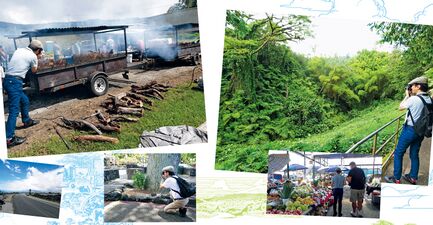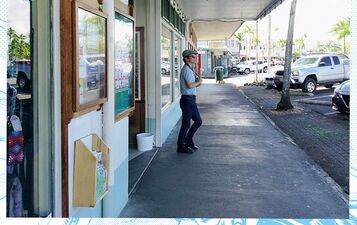Hirohiko Araki's Research Techniques (December 2023)
Ballad Kitaguni (December 2023)
Interview Archive

A research report of when Araki visited Hawaii, before the start of The JOJOLands. It was published in the Winter 2023 issue of JOJO magazine, released on December 19, 2023.
Interview
Before the serialization of Part 9: The JOJOLands, Hirohiko Araki flew to Hawaii. He boldly conducted on-site research on Oahu Island and Hawaii Island (aka. "the Big Island"), which are the settings for the story. What does Araki emphasize during his research, how does he act, and what does he gain? Based on the testimonies of the editors who accompanied him, this article delves into his "research techniques."
Written and composed by Kadokura Shima.
Araki has said that he always makes it a priority to personally conduct his own research. He picked out places he wanted to visit, including the school Jodio Joestar attends and the villa where Rohan Kishibe stays. Based on those choices, Araki and the editorial department discussed and organized an itinerary that covered both Oahu and Hawaii Island.
The research took place around the time when the rough draft for The JOJOLands was formed. The editor who accompanied him said, "Araki-sensei always writes the framework of the story in a sketchbook and explains it to us during meetings. But this time, we went on the research trip when the framework had somewhat solidified." (The text inside quotes are the editor's comments.)
In his book Hirohiko Araki's Manga Techniques, Araki says, "When you go to a location, you can clearly understand which parts you need, and you may even get unexpected ideas on the spot."
"I think the things we saw and heard on location fleshed out the 'bones' of the story... you could say it became more concrete."
The protagonist of Jodio was beginning to take shape within Araki's mind during the latter part of JoJolion's serialization. But as expected, the land of Hawaii and the people living there were instrumental to the creation of Jodio’s character. He also directly heard personal stories from locals, such as taxi drivers, which helped expand the image of Jodio. However, the foundation of Araki’s research is to carefully observe people’s actions. He closely observed how young people dressed (and it’s said that he "remembers what he saw very well").
"True observation... it doesn't mean looking around, it means looking around carefully... to not just listen, but to listen well."[1] Following this line from Jotaro Kujo, Araki’s constant "watching" is probably what fleshes out his characters and stories, increasing their realism.
In general, Araki takes all the photographs himself.
This time, Araki said, "I want to see what kind of plants grow over there (in Hawaii)," and he stayed at the botanical garden for a long time, capturing many plants with his camera.
Araki often captures a wide picture while also taking photos of the finer details. For example, with a fence, he takes pictures of how the mesh is woven and how the bolts are aligned.
“Nowadays, many people think that you can see everything on the internet, but there are still many things you can't understand unless you see them with your own eyes, like police car designs, the shape of a mailbox, mailmen uniforms, and what toilets are like” (from Hirohiko Araki's Manga Techniques).
An editor who saw Araki paying close attention to details said, "Perhaps Araki is working on enhancing the resolution of the story in his mind."
"Although the same events from the story don't happen in the places I visited for research, by actually seeing the locations where Jodio and the others would be active, burning the details into my mind, and enhancing my ideas of those places, I felt that I could depict those events as something that really happened — something that would make the readers feel as if Jodio truly exists in those places."
Although there were almost no major changes, such as canceling trips or flights, the time that was spent at specific locations was changed frequently. If Araki felt that he had done enough research, even if he still had time left there, he would wrap up early and spend more time at a different location. For example, he stayed at the location that became the model for the car scrapyard, where Jodio and the gang come and go, for more than twice the time he had planned.
While driving down an unremarkable road, Araki would suggest, "I want to see that area. Let's walk a little," and they stopped the car to take pictures of the road's details and the cooled, solidified lava on the ground.
In addition to acting on his own interests, he also reacted highly to chance encounters. For example, as soon as they entered one town, the smell of chicken was strong in the air. When they got out of the car, they discovered that chicken was being sold on the street. Araki immediately showed interest and took photos of the unusual way it was being grilled — using the bed of a truck modified as a grill.
Araki was particularly enthusiastic about researching places that tourists wouldn't like - everyday locations, like restaurants frequented by locals. The local guide who accompanied him prioritized Araki’s interests and acted flexibly. Although the guide initially provided explanations similar to those given to tourists, once the guide quickly understood what Araki was actually interested in, they guided him to places that were not originally on the schedule, asking, "Perhaps you want to see things like this instead?"
In this way, the itinerary was gradually adjusted according to Araki’s interests.
Araki was eager to listen to the guide’s explanations and actively asked questions, especially about the land itself. The formation of the land, its history, how people live there, and what kinds of people visit as tourists. He even noticed the wide variety of rocks and asked, "Why are there lava rocks with different shapes in the same place?"
According to the editor, "I think Araki-sensei has always had an interest in land. Even in Japan, while walking with Araki, there were times when he would suddenly point at the road and explain, 'This is a culvert."[a]
Not only in Hawaii, but in general, both Araki and the editor mentioned the significance of going to an actual location for research, saying, "When you go to the actual place, you develop an attachment to the land."
"I believe that there's something valuable in sharing the local atmosphere."
This is perhaps one of the most important things that can only be achieved by visiting a location in person — the attachment to the land and the shared experience of the atmosphere by those involved with the work.
Despire having an extremely packed schedule, Araki's seemingly infinite stamina surprised those accompanying him. Even in the heat, Araki remained active.
He wakes up early in the morning, swims in the hotel pool, and has a proper breakfast. He conducts his research tours until evening, and takes short walks in his spare time.
Seeing Araki like this, the editor said, "I felt that he was conducting research while enjoying himself. It's hard to work only out of a sense of duty, and one tends to do only what's necessary. But I think Sensei is someone who finds various things interesting. When he thinks something looks interesting, he moves quickly. He's really light-hearted and I want to learn more from him."
Finally... Though it does not directly relate to research techniques, I would like to share this story from the journey. Anytime Araki went to a restaurant, he changed from the shorts he wore during research into proper attire. The editor said, "I felt his respect for the restaurant," as it showed the humanity of Araki.
The Hawaii that Araki has been enjoying is what we readers are now experiencing through Part 9. I wonder what he will let us experience it in the future... I will wait with even more anticipation.
荒木飛呂彦の取材術
第9部『The JOJOLands』連載開始前、荒木飛呂彦はハワイへ飛んだ。物語の舞台となるオアフ島とハワイ島で現地取材を敢行したのだ。荒木飛呂彦は取材で何に重きを置き、どんなふうに動き、何を得ているのか――同行した編集者たちの証言をもとに、その「取材術」に迫る。
文・構成/門倉紫麻
取材は必ず自ら行くようにしている、と語ってきた荒木。行きたい場所、またジョディオ・ジョースターの通う学校や岸辺露伴が滞在する別荘のモデルなど見たい場所を荒木がピックアップし、それをもとに荒木と編集部が協議してオアフ島とハワイ島をめぐる旅程を組んだ。
取材時期は、『The JOJOLands』の大まかな物語ができた頃。同行した編集者は「荒木先生は打合せの際はいつもスケッチブックに物語の骨組みを書いて説明してくださるんですが、今回はその骨組みがある程度固まった段階で取材に行きました」(※以下「 」内は編集者のコメント)と話す。
荒木は著書『荒木飛呂彦の漫画術』で、現地に行くと〈自分が必要とする部分がどこなのかリアルにわかりますし、現場で思わぬアイディアが浮かぶことがあります〉と語っている。
「現地で見聞きしたことによって、“骨”に“肉”が付けられていったというか……具体化されていったのだと思います」
主人公・ジョディオのキャラクターの方向性は、『ジョジョリオン』の連載終盤から荒木の中で定まりつつあったというが、やはりハワイという土地と、そこに暮らす人々から得たものがキャラクターの具体化に大きく役立った。タクシー運転手など現地の人からキャラクターのイメージがふくらむような体験談を直接聞くこともあったが、荒木の取材の基本は人々の行動を「よく見る」こと。若者の服の着こなし方などもよく見ていたという(さらに「見たことをすごく覚えている」のだという)。
また、現地の人々だけでなく、編集者やガイドなど同行者の行動も、荒木は「見る」。例えば、レンタカーショップでは、編集者たちが車を借り、乗り込む流れを見ていた荒木。第2話には、その体験をもとにしたと思われる、ジョディオ一行がハワイ島のコナ空港でレンタカーショップに立ち寄るくだりを登場させている。ジョディオたちが思い思いに車に乗り込み、レンタカーショップ店員の呼び込みの声を背にレンタル料について会話する様子など(もちろん編集者たちの会話内容とは異なるが)、短い描写の中に濃厚なリアリティが漂っている。
〈観察しろというのは……/見るんじゃあなくて観ることだ…/聞くんじゃあなく聴くことだ〉。[1] 空条承太郎のこのセリフにならえば、荒木がこうして常に“観て”いることが、キャラクターや物語を肉付けし、リアリティを高めているのだろう。
写真の撮影は、基本的に荒木自身が行う。
今回荒木は“そこ(現地)にどんな植物が生えているかとか、見たいんだよね”と、植物園にも長く滞在、多くの植物をカメラに収めた。
荒木は、全体像をおさえつつも細部を撮ることが多い。例えばフェンスなら、網目はどう編まれているのか、ボルトはどう止まっているのか、など細かな部分を撮影していくのだ。
〈今はネットでなんでも見られると多くの人が思っているかもしれませんが、例えばパトカーのデザインやポストの形、郵便配達人の服装、トイレがどうなっているかなど、自分の目で見ないとわからないこともたくさんあるのです〉(『荒木飛呂彦の漫画術』より)
現地で細部にこだわる姿を見た編集者は、荒木は「脳内の物語イメージの解像度を上げる作業をしているのではないか」と話す。
「取材した場所で、実際に作中と同じことが起きているわけではないですが、ジョディオたちが活躍する舞台である各ロケーションを実際に目にして細部まで脳に焼き付け、その場の解像度を上げることで、限りなく実在に近いものとして――この場所にジョディオが存在している、と読者に思わせることができるレベルのものとして、描けるようになるのだと感じました」
取材先に行くのを取りやめるなど大幅な予定変更はほぼなかったものの、時間配分は度々変更された。
現地で、荒木が十分取材ができたと思えば、時間が余っていても切り上げて別の取材に時間をかける。例えば、作中でジョディオらが出入りする車のスクラップ工場のモデルになった場所では、予定していた倍以上の時間、滞在している。
一見特徴のなさそうな道を車で走っている際に、荒木が“あの辺りが見たいな。ちょっと歩こうよ”と提案、車を止めて道路のディティールを撮影したり、冷えて固まった溶岩の写真を撮ることもあった。
また、自身の興味で動くだけでなく、偶然の出会いにも敏感に反応する。例えば、ある街に入った途端、濃厚なチキンの匂いが漂ってきたことがあり、車から降りてみたところ、チキンの路上販売が行われていることがわかった。すると、荒木はすぐに興味を示し、その珍しい焼き方――トラックの荷台を改造しチキンを焼いていた――の細部まで写真に収めた。
荒木が特に熱心に取材したがったのは、観光客が好むような場所ではなく、現地の人々が通いそうな飲食店など日常的な場所。同行の現地ガイドも、そんな荒木の興味を優先して臨機応変に動いた。当初は観光客を案内する時と同じような説明をしていたものの、早々に荒木がどんなことに興味を持つかを理解すると、こういうものが見たいのでは? と予定にはなかった場所にも案内した。
こうして荒木の興味によって旅程も少しずつアレンジされていった。
荒木が、特にガイドの説明に熱心に耳を傾け、自らも積極的に質問していたのは土地に関すること。その土地の成り立ちや、歴史、人々がそこでどう暮らしているのか、どんな人が観光に来ているのか――。“なぜ同じ場所に形状の違う溶岩が存在するのか”と自ら気づき、質問することもあった。
編集者いわく「荒木先生は、もともと土地に興味がある方だと思います」。日本でも荒木と共に歩いている時に、ふと“ここは暗渠[b]なんだよ”と道路を指して説明されることがあったのだという。
また今回のハワイに限らず、荒木本人だけでなく編集者も取材で現地に足を運ぶことの意義を“現地に行くと、その土地に愛着がわくから”と語っていたという。
「現地の空気を共有することを大事にされているのだと思います」
作品に関わる者がその土地に愛着を持ち、空気を共有する――現地取材でしか得られない、最も大きなものの1つかもしれない。
かなりの過密スケジュールの中、同行者を驚かせたのが荒木の「無限のように思える」体力。暑い中でも、荒木はずっとアクティブだった。
朝は早くに起床、ホテルのプールでひと泳ぎし、朝食もしっかりとる。夕方まで取材をこなし、短い空き時間には散歩もする。
そんな姿を見た編集者は「楽しみながら取材をしているように感じました」と口にする。「仕事の義務感だけで動くのはつらいし、だんだん必要なことしかやらなくなりがちですよね。でも先生は、いろいろなことを面白いと思う方なのかなと。面白そうだと思ったら、パッと動く。本当に軽やかで見習いたいと思いました」
最後に……取材術と直接関わりはないが、旅の中での、こんなエピソードを。レストランなど食事の場所に、荒木は取材中に着ていた短パンからきちんとした服装に着替えてから出向くのだという。「お店への敬意を感じました」と編集者が言うように、荒木飛呂彦の人間性が感じられる。
荒木が楽しみながら取り込んできたハワイを今、我々読者も物語を通して味わっている。今後どんな形で味わわせてくれるのか……さらに期待して待ちたい。
Gallery
Notes
Site Navigation
- ↑ Jump up to: 1.0 1.1 Chapter 355: Sheer Heart Attack, Part 2








